A View You’d See From An Asteroid’s Surface!
A view you’d see from an asteroid’s surface!
Japan’s space agency (JAXA) has successfully landed two small rovers on the asteroid Ryugu. Their “mothership” Hayabusa 2 reached the asteroid in summer at a distance of 313 million km (194 million miles) from Earth, a journey which took 3.5 years. Rover-1B captured this video of 15 frames on September 23, 2018.
Another spectacular sight was the Hayabusa 2 spacecraft’s shadow visible on the surface before releasing the rovers:

The mission’s goal is to study this potentially hazardous asteroid, and bring back a sample in 2020! Asteroids are not only space rocks that might collide with our planet, though. They are remnants from our solar system’s formation and help to investigate the origin of life and the Earth’s oceans.
⭐ Stay connected with Sci-universe on Tumblr and Instagram 📸: JAXA / Roman Tkachenko via @haya2e_jaxa
More Posts from Riekod and Others
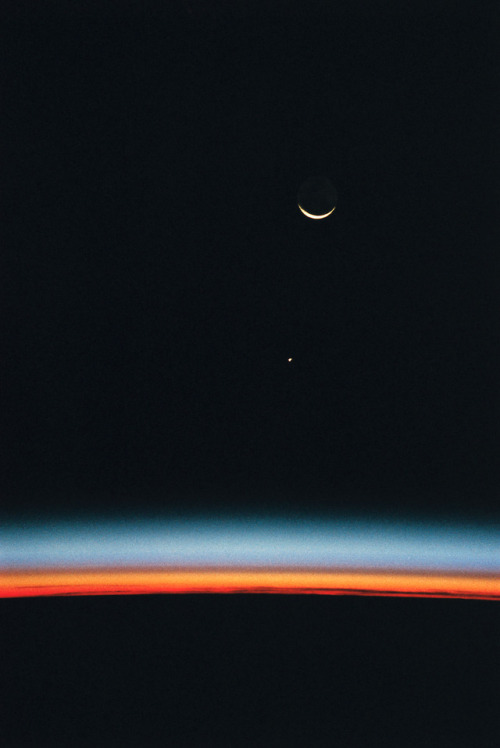
This scene, captured with a 35mm camera from inside the Space Shuttle Endeavour, shows Jupiter rising above the airglow over Earth’s horizon. The crescent Moon is at top frame.
Credit: NASA


Night sky
Lieksa, Finland
October 2018
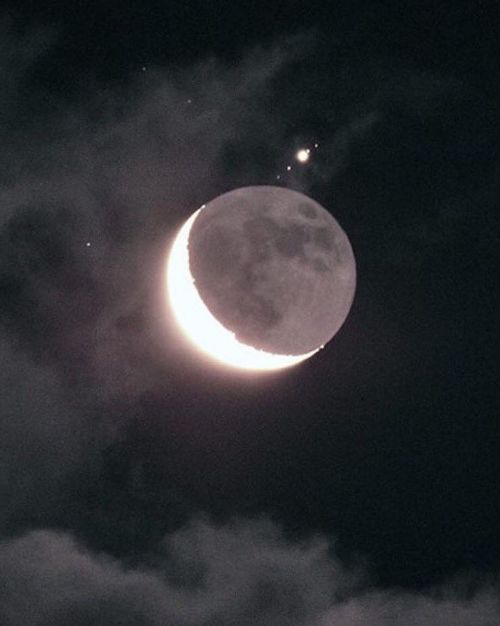
Jupiter and 4 of her moons peaking out from behind our moon!

Lunar Eclipse 2019
Image Credit: Zachary Wells
“The most exciting phrase to hear in science, the one that heralds new discoveries, is not ‘Eureka!’ (I’ve found it!), but ‘That’s funny…’”
— Isaac Asimov | Author - I, Robot | Professor - Biochemistry
Stellar Winds
Stellar winds are fast moving flows of material (protons, electrons and atoms of heavier metals) that are ejected from stars. These winds are characterised by a continuous outflow of material moving at speeds anywhere between 20 and 2,000 km/s.
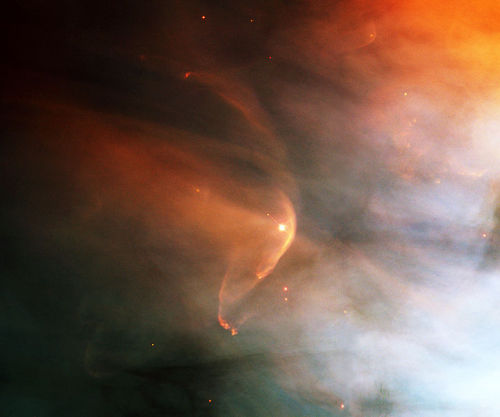
In the case of the Sun, the wind ‘blows’ at a speed of 200 to 300 km/s from quiet regions, and 700 km/s from coronal holes and active regions.

The causes, ejection rates and speeds of stellar winds vary with the mass of the star. In relatively cool, low-mass stars such as the Sun, the wind is caused by the extremely high temperature (millions of degrees Kelvin) of the corona.

his high temperature is thought to be the result of interactions between magnetic fields at the star’s surface, and gives the coronal gas sufficient energy to escape the gravitational attraction of the star as a wind. Stars of this type eject only a tiny fraction of their mass per year as a stellar wind (for example, only 1 part in 1014 of the Sun’s mass is ejected in this way each year), but this still represents losses of millions of tonnes of material each second. Even over their entire lifetime, stars like our Sun lose only a tiny fraction of 1% of their mass through stellar winds.

In contrast, hot, massive stars can produce stellar winds a billion times stronger than those of low-mass stars. Over their short lifetimes, they can eject many solar masses (perhaps up to 50% of their initial mass) of material in the form of 2,000 km/sec winds.

These stellar winds are driven directly by the radiation pressure from photons escaping the star. In some cases, high-mass stars can eject virtually all of their outer envelopes in winds. The result is a Wolf-Rayet star.

Stellar winds play an important part in the chemical evolution of the Universe, as they carry dust and metals back into the interstellar medium where they will be incorporated into the next generation of stars.
source (read more) + Wolf–Rayet star
Studying physics is essentially being taught a simple structure, and then told ”actually, scratch that, the truth is actually far more complicated” over and over again until we reach the point where we still don’t know the truth, only that we do not have it.
In “Float” artist Susi Sie uses water and oil to create a whimsical landscape of bubbles and droplets. Coalescence is a major player in the action, though Sie uses some clever time manipulations to make her bubbles and droplets multiply as well. Watching coalescence in reverse feels like seeing mitosis happen before your eyes. (Video and image credit: S. Sie)



Thoughts and explanation about time travelling through a black hole?
A black hole curves the space-time fabric to an extreme point called singularity. And since space and time are working together, according to the theory of relativity, curvature and gravity also affect time.
This is best illustrated by one person (call them Unlucky) falling into a black hole while another person (call them Lucky) watches. From Lucky’s perspective, Unlucky’s time clock appears to be ticking slower and slower. This is in accordance with Einstein’s theory of general relativity, which (simply put) says that time is affected by how fast you go, when you’re at extreme speeds close to light. The black hole warps time and space so much that Unlucky’s time appears to be running slower. From Unlucky’s perspective, however, their clock is running normally and Lucky’s is running fast.
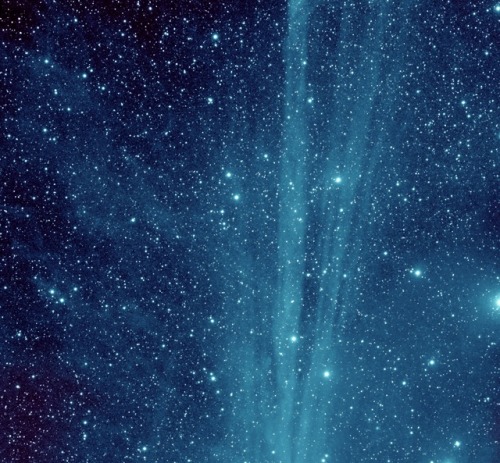
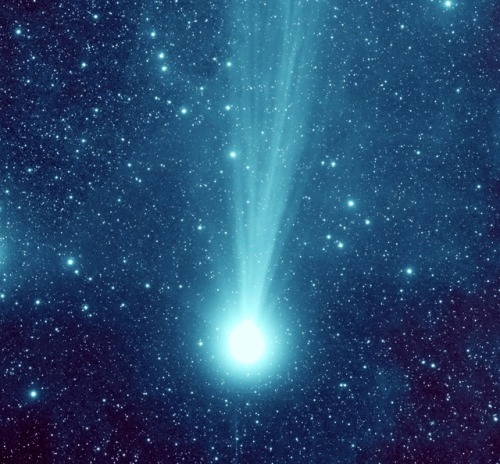
Comet C/2014 Q2 Lovejoy
by Joseph Brimacombe
-
 wakayume liked this · 8 months ago
wakayume liked this · 8 months ago -
 thegentlemanstar liked this · 1 year ago
thegentlemanstar liked this · 1 year ago -
 brightspine reblogged this · 1 year ago
brightspine reblogged this · 1 year ago -
 brightspine liked this · 1 year ago
brightspine liked this · 1 year ago -
 spaceoperajay reblogged this · 1 year ago
spaceoperajay reblogged this · 1 year ago -
 petrsswevery liked this · 1 year ago
petrsswevery liked this · 1 year ago -
 studdedblurb reblogged this · 1 year ago
studdedblurb reblogged this · 1 year ago -
 odinsblog liked this · 1 year ago
odinsblog liked this · 1 year ago -
 resrivertend liked this · 1 year ago
resrivertend liked this · 1 year ago -
 truff1es liked this · 1 year ago
truff1es liked this · 1 year ago -
 espacito reblogged this · 3 years ago
espacito reblogged this · 3 years ago -
 intrusivetoxin liked this · 3 years ago
intrusivetoxin liked this · 3 years ago -
 marvdam reblogged this · 3 years ago
marvdam reblogged this · 3 years ago -
 marvdam liked this · 3 years ago
marvdam liked this · 3 years ago -
 cherryball1234321 liked this · 3 years ago
cherryball1234321 liked this · 3 years ago -
 n-e-l-z liked this · 4 years ago
n-e-l-z liked this · 4 years ago -
 wearerugged reblogged this · 4 years ago
wearerugged reblogged this · 4 years ago -
 stuffandspaghetti liked this · 4 years ago
stuffandspaghetti liked this · 4 years ago -
 sergrusso reblogged this · 4 years ago
sergrusso reblogged this · 4 years ago -
 retrorudy liked this · 4 years ago
retrorudy liked this · 4 years ago -
 richardmark1 reblogged this · 5 years ago
richardmark1 reblogged this · 5 years ago -
 richardmark1 liked this · 5 years ago
richardmark1 liked this · 5 years ago -
 cavernario-galindo liked this · 5 years ago
cavernario-galindo liked this · 5 years ago -
 good-bokeh liked this · 5 years ago
good-bokeh liked this · 5 years ago -
 richhurt reblogged this · 5 years ago
richhurt reblogged this · 5 years ago -
 richhurt liked this · 5 years ago
richhurt liked this · 5 years ago -
 sylvanthorn liked this · 5 years ago
sylvanthorn liked this · 5 years ago -
 boa-cervidae reblogged this · 5 years ago
boa-cervidae reblogged this · 5 years ago